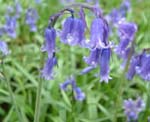Save the British Bluebell
Wild bluebells are already starting to open in southern-counties woods, but the elegant British species faces a number of threats


Savour the sight of an azure woodland river of native bluebells; it s a spectacle that might not be with us in future generations. Traditionally one of the great natural displays of May, especially in old deciduous woods, the bluebell has been the subject of recent surveys (by the botanical charity Plantlife), which reveal that it is under threat from a number of sources, not least from its paler, more muscular cousin from the Mediterranean. It s easy to spot the difference between the two species, once you know what you re looking for.
The captivating British bluebell (once euphoniously called Endymion non-scriptus, now known as Hyacinthoides non-scripta) nods its head like a shepherd s crook at flowering time, with all the flowers slender bells of an electrifying deep violet-blue hanging downwards and turned in the same direction. Hyacinthoides hispanica, on the other hand, a species of the Iberian peninsula, bears paler, more upright bells arranged loosely round a sturdy stem, and bears broader leaves.
Things are complicated by the fact that the two species have hybridised, and often it s the vigorous hybrids that are getting a foothold in the native bluebell s habitat. Spanish bluebells were brought into gardens more than two centuries ago. Like Rhododendron ponticum and the grey squirrel, at the time it no doubt seemed an innocuous species to release into a cultivated landscape. Sometimes, well-meaning people have planted bulbs of the Spanish bluebell in woodland habitats, mistaking them for the indigenous kind. Expanses of native bluebells have also been dug up by unscrupulous traders over the years, although it s illegal to do so now. Nevertheless, hispanica is a poor substitute for the demure countenance and ravishing, inky pools presented by non-scripta.
Bluebells are members of the Lily family, along with many other heralds of spring, including grape hyacinths, wild garlic, fritillaries, snowdrops and snowflakes. British bluebells are mainly (but not exclusively) woodland plants, but in northern regions where trees are sparse, colonies can still thrive where there is sufficient humidity, such as a bracken-covered hillside, or even in shadowed, treeless ravines. Only the toxic, acid litter of conifer plantations seems able to drive them out, and even here they can slowly move back once the conifers have been removed, advises Richard Mabey in Flora Britannica.
Climate change seems to be the reason that bluebells are flowering earlier than May. The Natural History Museum, in association with Plantlife, has launched its 2008 Bluebell Survey, in which everybody is invited to take part. An important part of this survey is to look at bluebells wherever they are found. We want to know about bluebells in their familiar woodland setting as well as those growing in gardens, parks and the urban environment.
For more information on the survey, or to obtain bluebell hybrid identification leaflets, visit www.plantlife.org.uk
Exquisite houses, the beauty of Nature, and how to get the most from your life, straight to your inbox.
Country Life is unlike any other magazine: the only glossy weekly on the newsstand and the only magazine that has been guest-edited by His Majesty The King not once, but twice. It is a celebration of modern rural life and all its diverse joys and pleasures — that was first published in Queen Victoria's Diamond Jubilee year. Our eclectic mixture of witty and informative content — from the most up-to-date property news and commentary and a coveted glimpse inside some of the UK's best houses and gardens, to gardening, the arts and interior design, written by experts in their field — still cannot be found in print or online, anywhere else.
